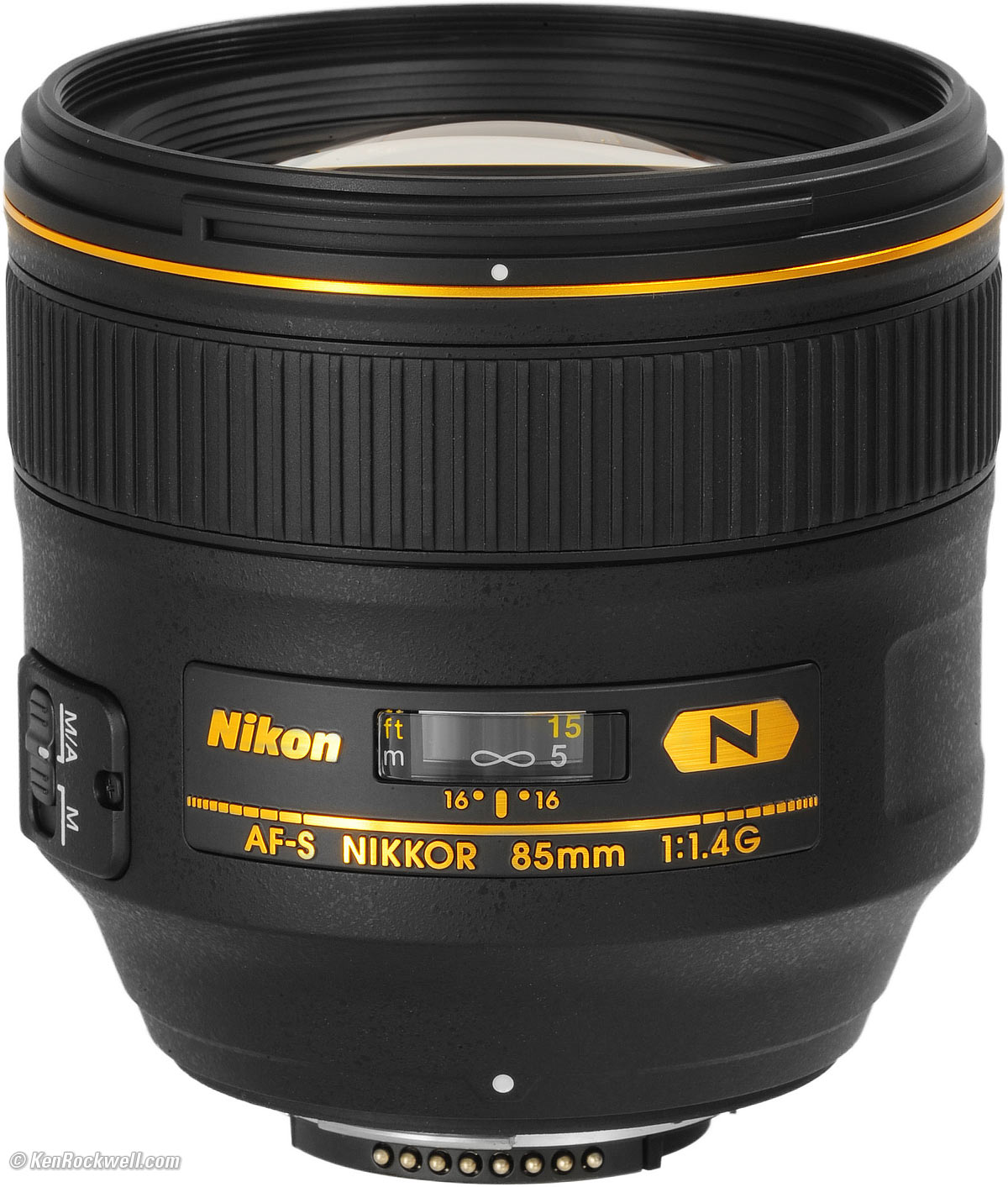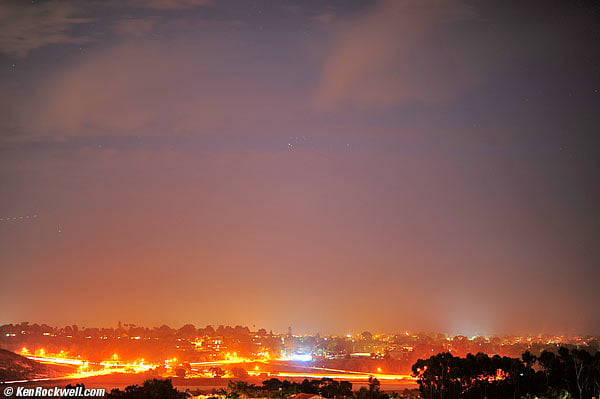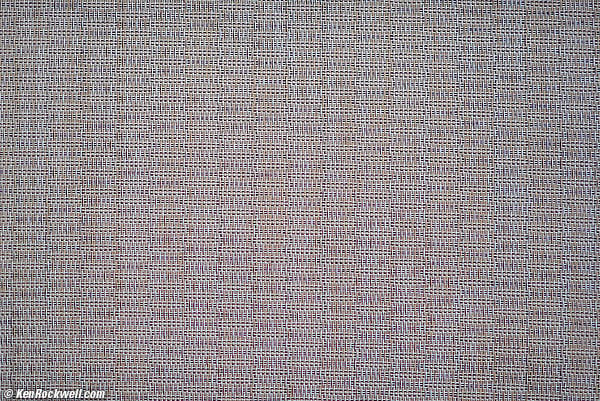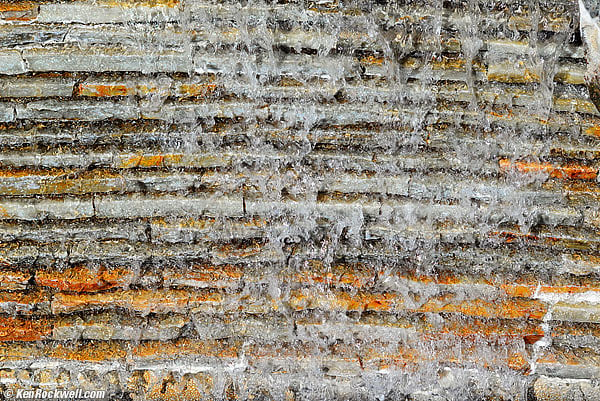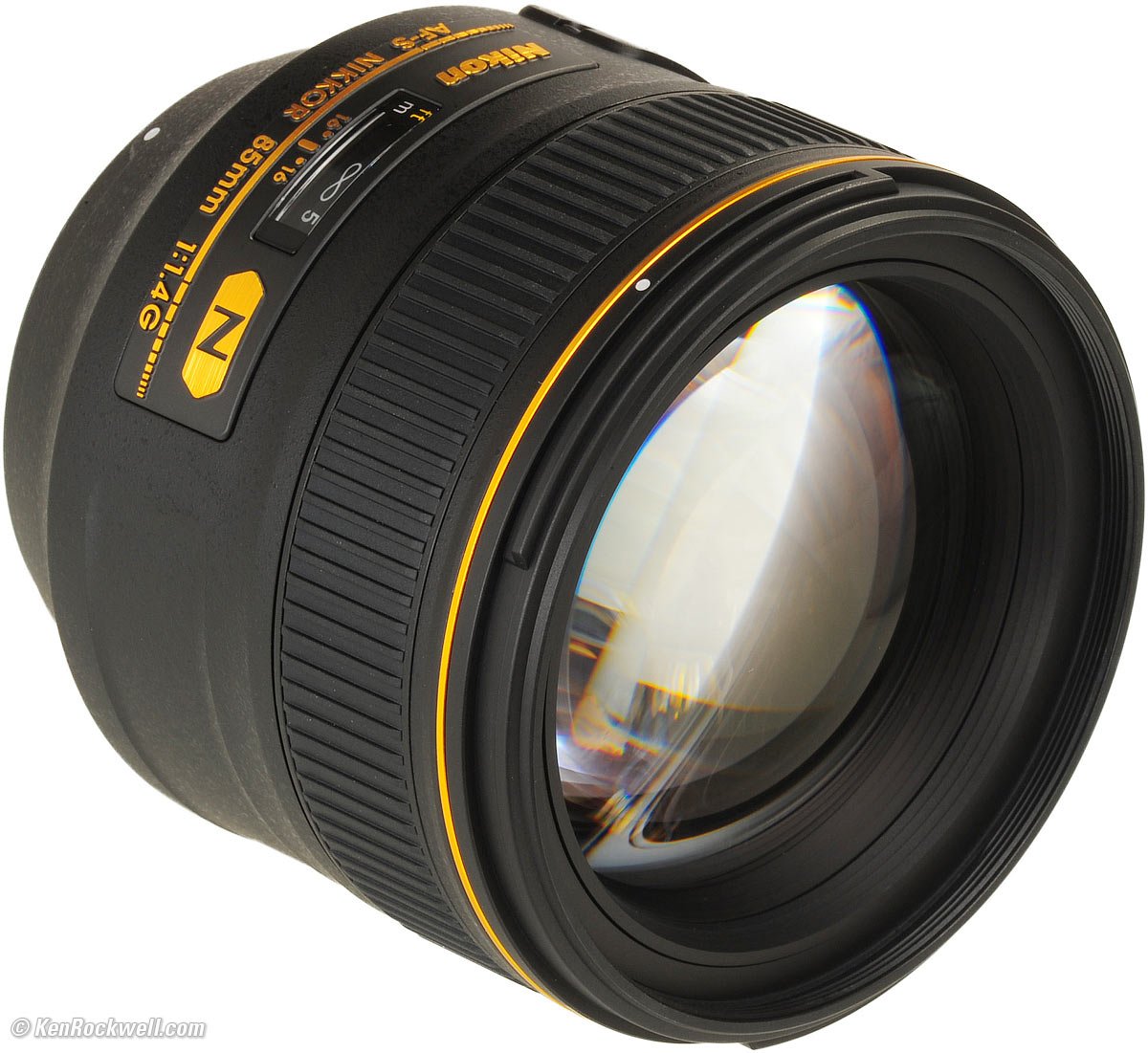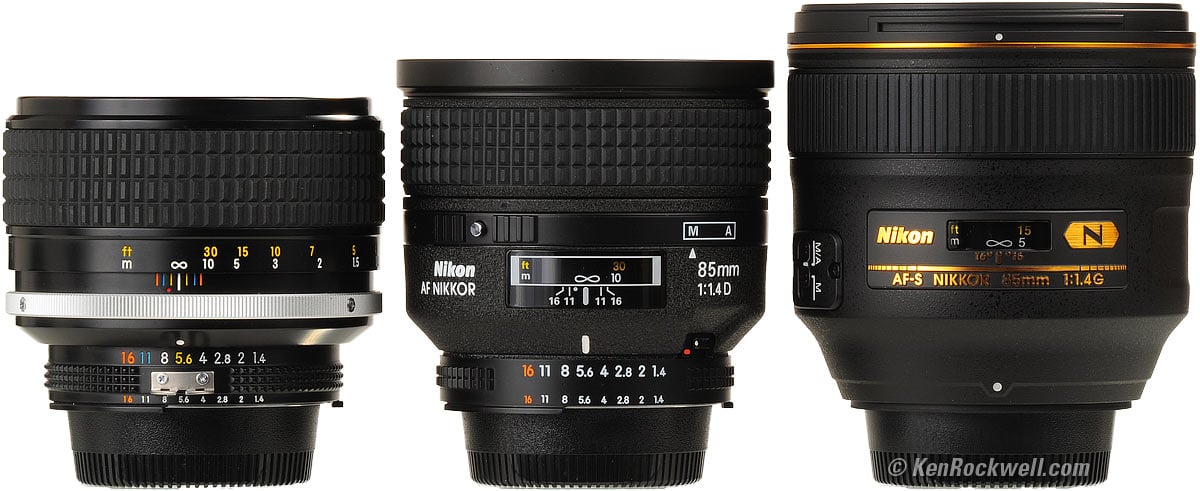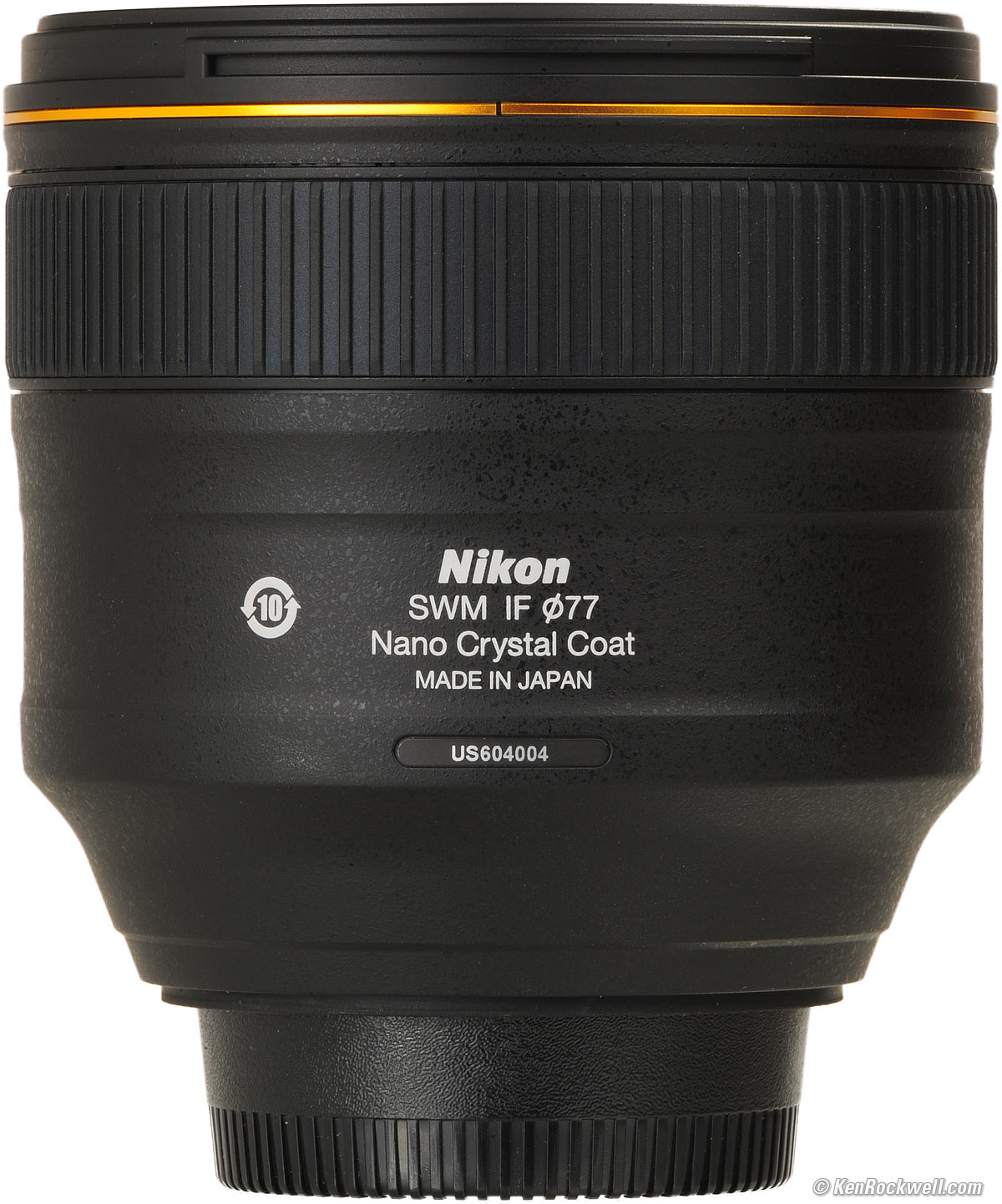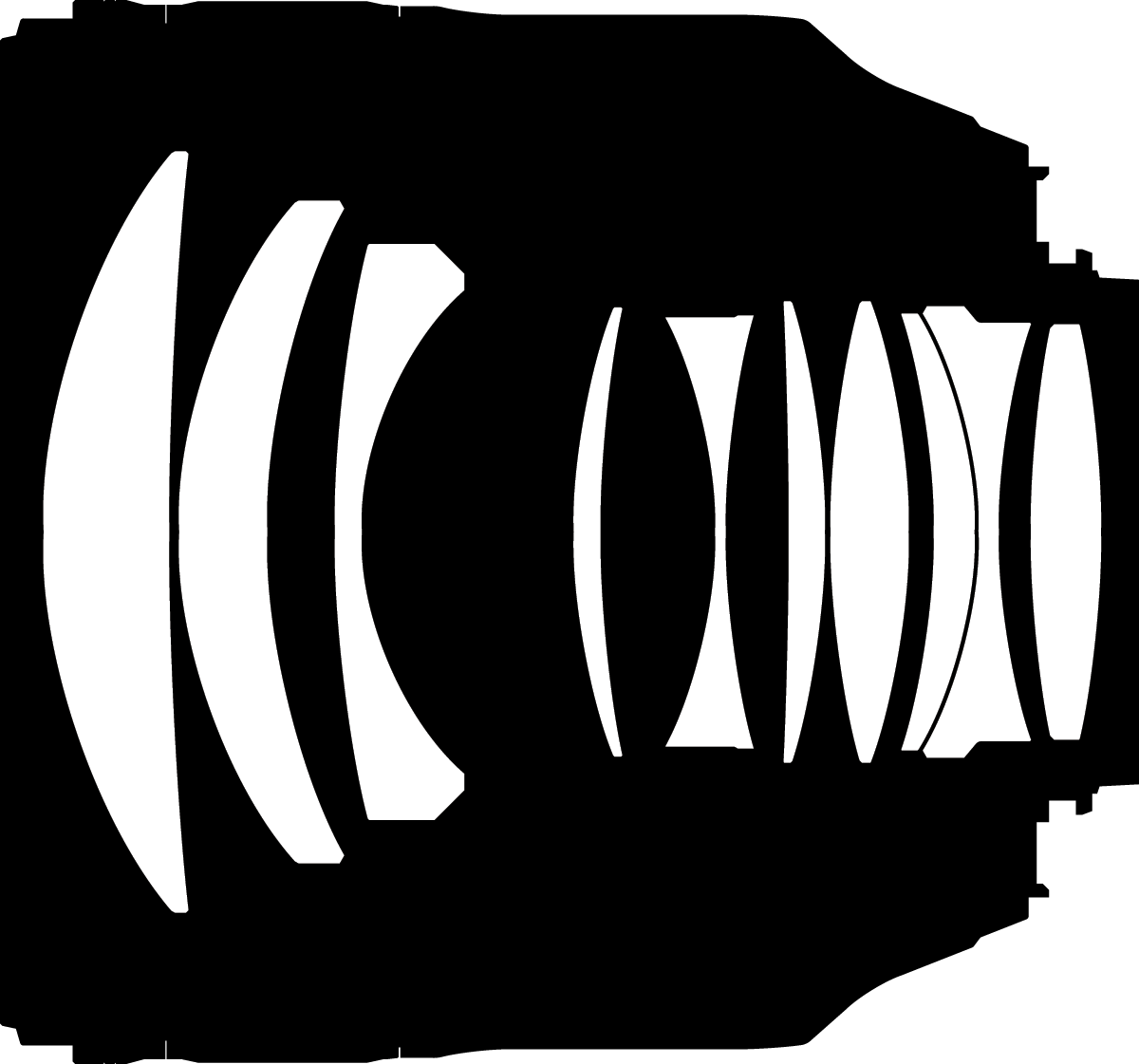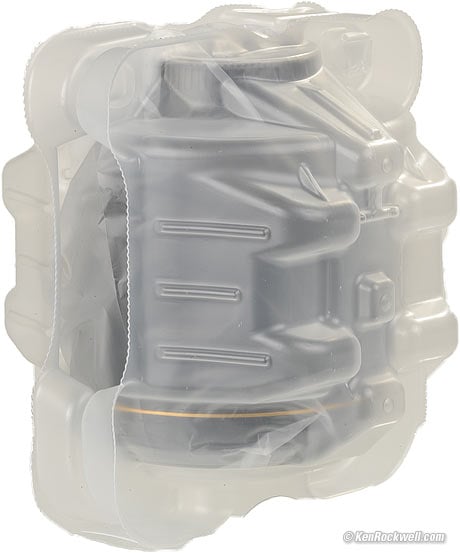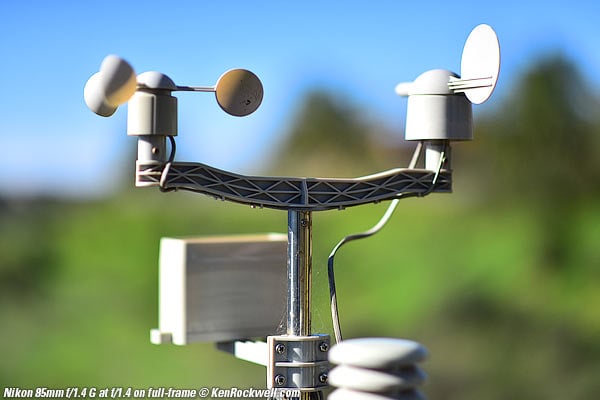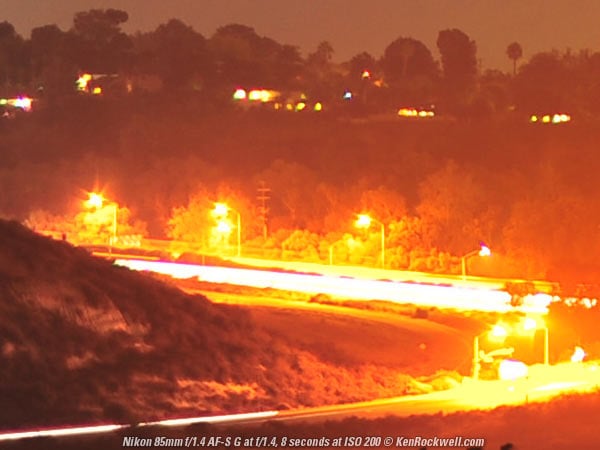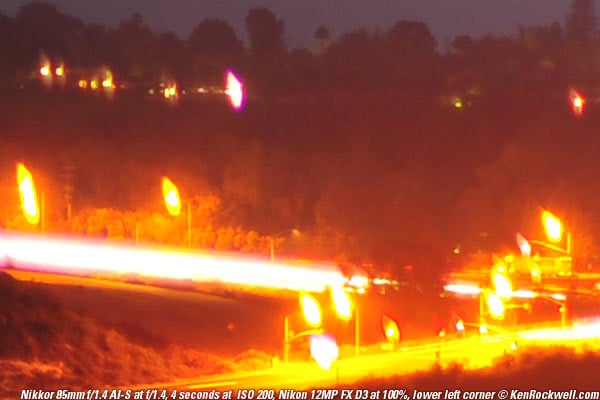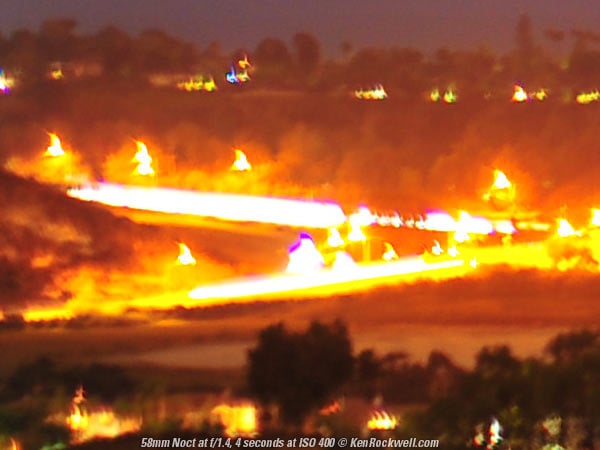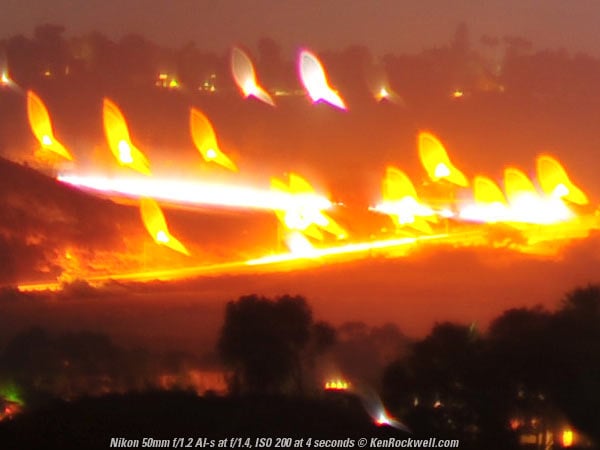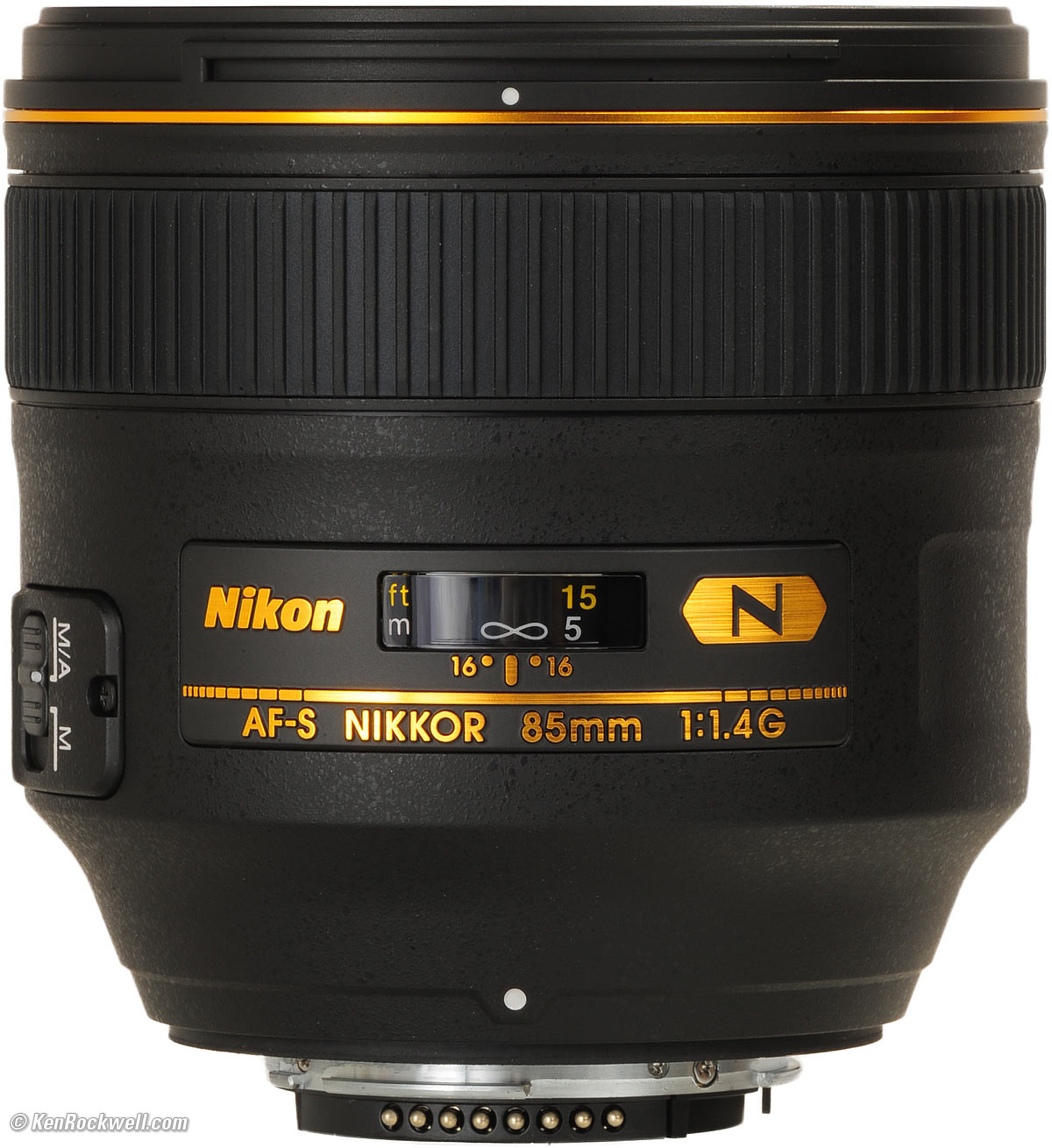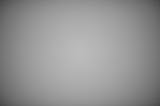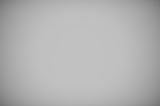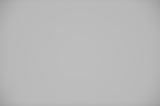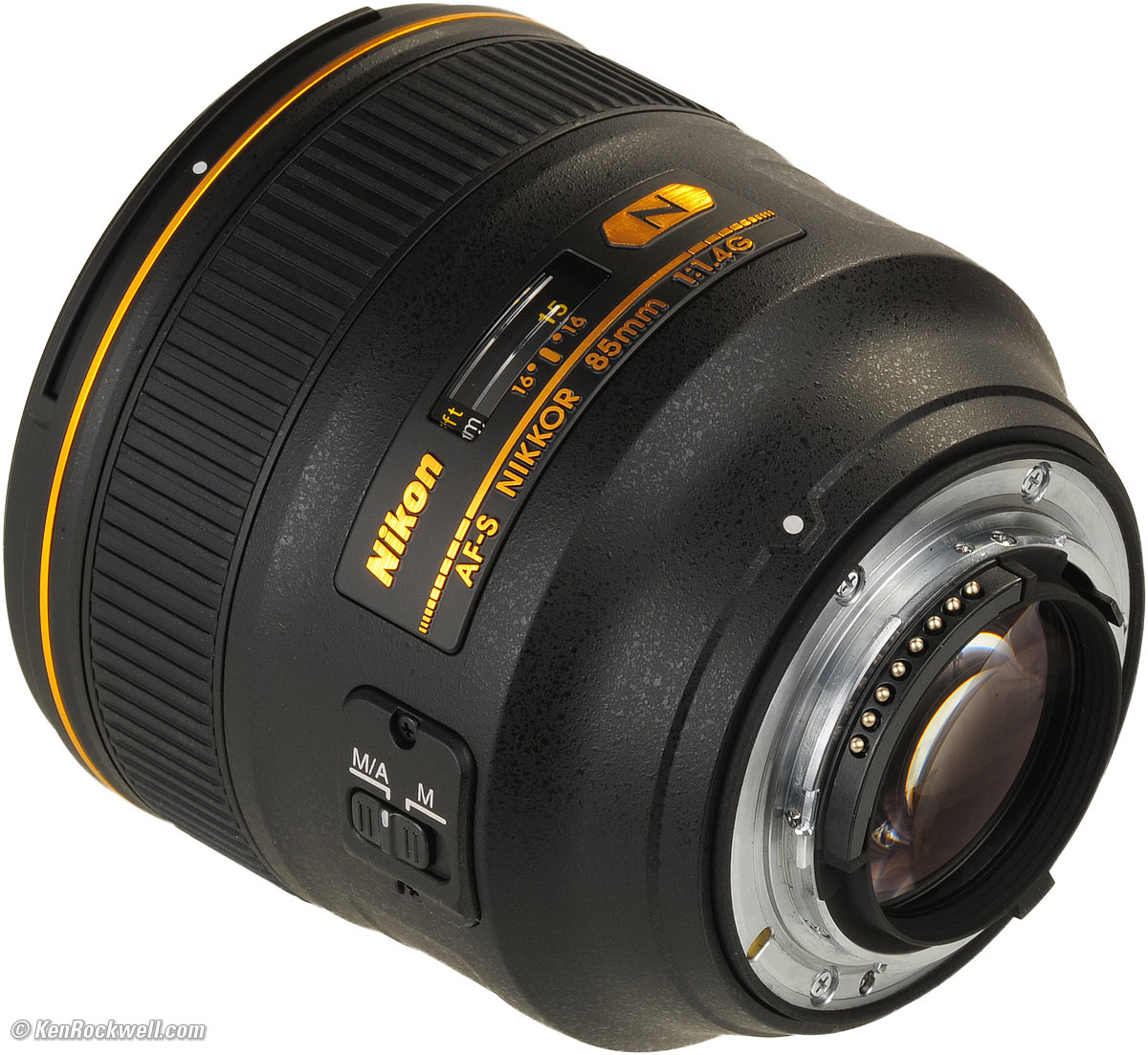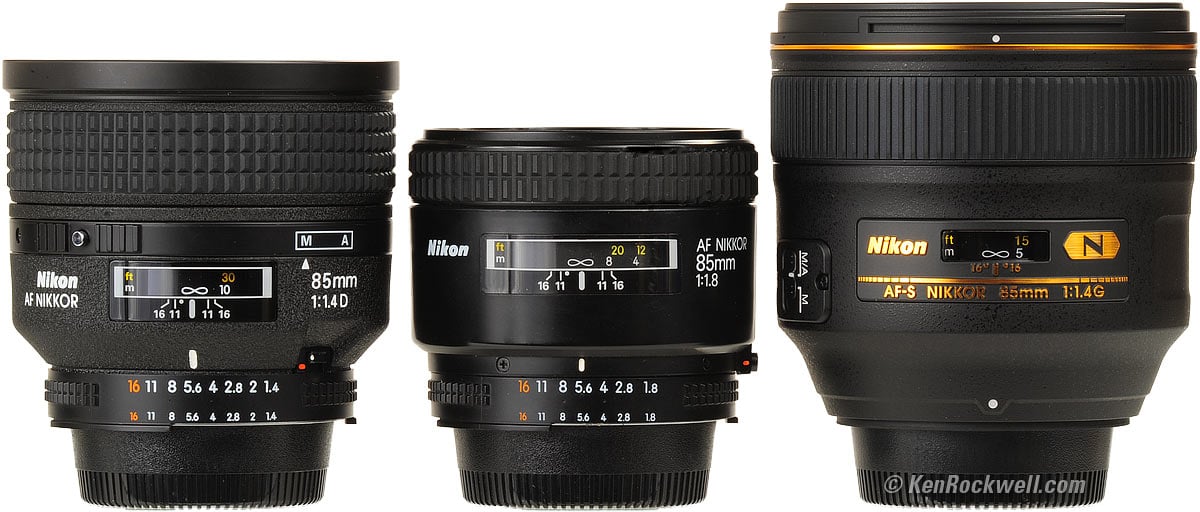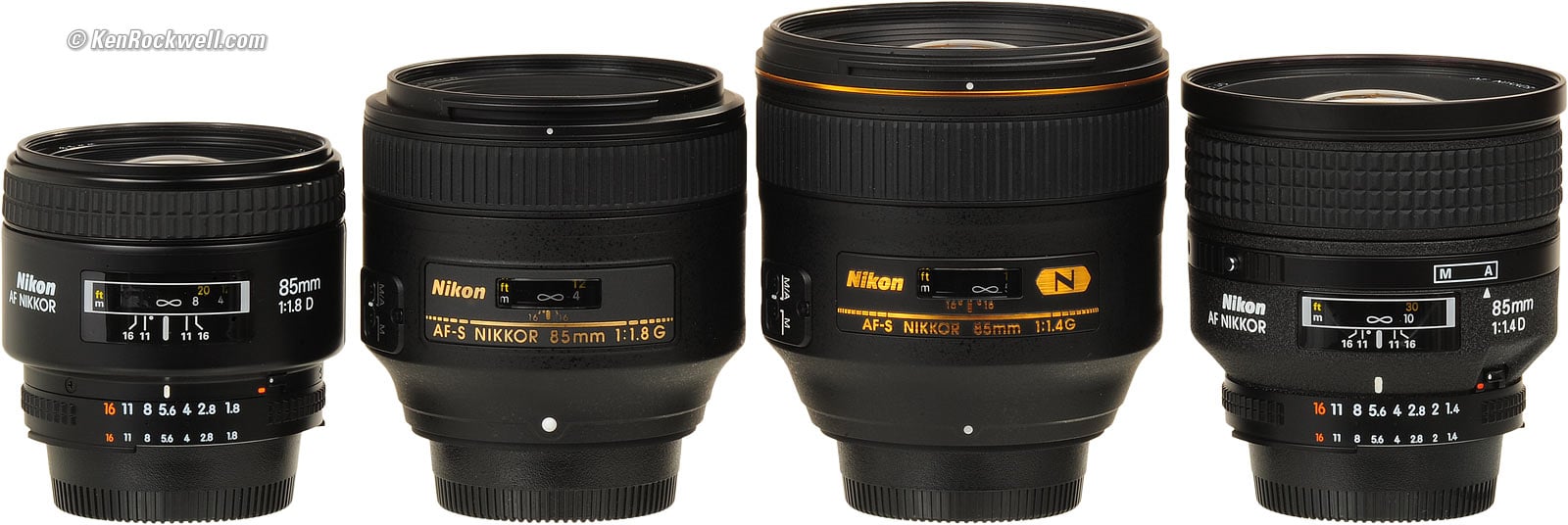Home Donate New Search Gallery Reviews How-To Books Links Workshops About Contact
Nikon 85mm f/1.4 G
Full-Frame AF-S NIKKOR (2010-)
Intro Specifications Performance Compared Recommendations
Nikon 85mm f/1.4 AF-S G N (77mm filters, 20.8 oz./591g, 2.6'/0.8m close focus, about $1,597). enlarge. I bought mine at Adorama, and at Amazon is also a great source. My biggest source of support for this free website is when you use those or any of these links when you get anything, regardless of the country in which you live. It helps me keep adding to this free website when you get your things through these links — but I receive nothing for my efforts if you buy elsewhere. Please always use those or these links for the best prices and service. Thanks for helping me help you! Ken.
Adorama pays top dollar for your used gear, especially the older model 85mm f/1.4 AF-D.
January 2017 Nikon Reviews Nikon Lenses All Reviews
Too-hideous-to-publish sample image at f/1.4 (look at the bokeh, try to ignore the subject (you were warned), © 1.4 MB BASIC JPG shot in a dirty mirror.)
85mm f/1.4 AI-s Review (1981-2006)
85mm f/1.4 AF-D Review (1995-2010)
Ideal for
Incredible ability to bring a sharp subject forward from a velvety-smooth background, giving three-dimensional images, at many apertures.
Perfect as a general short tele on FX digital and film, and as a tele on DX. This f/1.4 lens is exceptionally well qualified for use in dim light, and for any shots in which you need limited depth-of-field.
The 85mm f/1.4 has been a staple lens of serious professional photographers for decades for all these reasons.
Not for
Won't work on manual-focus 35mm cameras. For them, use the Nikon 85mm f/1.4 AI-s instead.
Sample Image Files
Nacht at f/1.4, 28 September 2010. Camera-original © 1.5 MB BASIC JPG file.
At f/2: Clubhouse, 28 November 2013. Nikon D610, Nikon 85mm f/1.4 G, f/2 at 1/4,000 at ISO 100, Auto ADR, VIVID Picture Control with 6 sharpening and +3 saturation. Camera-original © LARGE BASIC Optimum Quality JPG (4.5 MB). AHA! Pretty darn sharp for a shot made at f/2 in daytime!
At f/1.4: Fabric, 28 November 2013. Nikon D610, Nikon 85mm f/1.4 G, f/1.4 at 1/1,250 at ISO 100, Auto ADR, VIVID Picture Control with 6 sharpening and +3 saturation. Camera-original © LARGE BASIC Optimum Quality JPG (4.9 MB). AHA! Pretty darn sharp for a shot made at f/1.4 at macro range of lawn furniture that isn't really flat!
At f/6.3: Waterfall, 28 November 2013. Nikon D610, Nikon 85mm f/1.4 G, f/6.3 at 1/640 at ISO 100, Auto ADR, VIVID Picture Control with 6 sharpening and +3 saturation, Athentech Perfectly Clear. Full resolution (5 MB). The waterfall isn't flat, so not everything is in focus.
Introduction top
Intro Specifications Performance Compared Recommendations
|
Adorama pays top dollar for your used gear. I use these stores. I can't vouch for ads below.
|
The Nikon 85mm f/1.4 AF-S G is simply astonishing. It is the first lens I have ever used in over 40 years of photography that excels at both the scientific aspects (sharpness and lack of coma, especially at f/1.4 in the corners), and the artistic aspects of defocus, all at the same time. Every other lens I've used is either super-sharp, but renders distracting backgrounds (most aspherical lenses), or others may may have pleasant bokeh, but aren't always that sharp (like the previous 85mm f/1.4 AF-D, whose corners never really get sharp).
This is probably why the few other people who already have this new lens have also been trying to pick themselves up off the floor after shooting with it.
Nikon 85mm f/1.4 AF-S G N. enlarge.
This Nikon 85mm f/1.4 is one of the best lenses ever made. It is super-sharp, even at f/1.4. Out-of-focus backgrounds simply melt away into undistracting softness due to this lens' spectacular bokeh, at many apertures.
It works magnificently on the 36 MP D810.
This lens' images quickly grab the attention of anyone who's paying attention. The subject pops into extreme sharpness, while the backgrounds just melt away into velvety smoothness.
This new 85mm f/1.4 does this not at just f/1.4; it does this at every aperture. It is super-sharp even at f/1.4 clear out to the corners, and backgrounds remain soft and undistracting even at smaller apertures. The guys at Nikon really pulled off a very subtle and powerful thing with the bokeh of this lens, as I sort of expected, but never to this extent.
The images made by this lens are simply beautiful. I usually want everything ultrasharp, which this lens does, but if there are backgrounds, they fade away into smooth softness, not the unsharp business of lesser lenses.
Backgrounds never distract, even at smaller apertures.
For artists, this allows us to create three-dimensional images with subjects that rise out of their backgrounds. For scientists, it allows more sharpness at faster apertures than any other Nikon lens. (The 200mm f/2 VR II is also very sharp, but a stop slower.)
For scientists, this 85's corner coma performance easily exceeds the exotic 58mm f/1.2 Noct-NIKKOR. Both the Noct and this 85/1.4 have no coma to keep points of light sharp in the corners wide-open, and this 85/1.4 is much sharper than the Noct in the corners at large apertures. Good-night, Noct!
Nikon's new 85mm f/1.4 lens is the latest professional lens from Nikon, replacing the clunkier old 85mm f/1.4 AF-D (1995-2010). Professional photographers have been expecting this AF-S lens since 2007 when Nikon unveiled their first full-frame digital camera, the D3.
Throughout history, when a pro photographer has mentioned their very favorite lens, it's either their f/2.8 tele, or their 85mm f/1.4 lens, either the 85mm f/1.4 AI-s (1981-2006) or the 85/1.4 AF-D (1995-2010). 85mm f/1.4 lenses are this good and this useful to professionals who know what they want, as opposed to trying to cover every unnecessary focal length with a slew of zooms.
85mm f/1.4 lenses deliver the goods, and this new AF-S is by far Nikon's best 85/1.4 yet.
This new Nikon 85mm f/1.4 improves on the previous versions by adding instant manual-focus override, and has optical performance far superior to either of Nikon's previous, and also excellent, 85mm f/1.4 AI-s and 85/1.4 AF-D.
The old 85/1.4 AF-D required moving a control ring to go between auto and manual focus. Good riddance, especially since this lens is usually used for portraits and action, like rock concerts, where instant access to manual focus is a must-have.
Refreshing is that Nikon hasn't pimped-out this professional lens. This 85/1.4 has no aspherical elements, no ED glass and no VR, just great performance through traditional optics done brilliantly.
Everything works perfectly on every digital Nikon, both FX and DX, and even on Nikon's cheapest digitals like the D40, D40x, D60, D3000, D3100 and D5000.
It's also perfect on decent or recent AF film cameras like the F6, F100, F5, N80 and N75.
The incompatibilities for older or cheaper film cameras are that:
1.) It won't autofocus with the cheapest new AF film cameras like the N55, but if you focus manually, everything else works great. Even if you lose autofocus, these cameras have in-finder focus confirmation dots to help you.
2.) Late 1980s ~ early 1990s AF cameras like the N90s, N70 and F4 will focus just fine, and you'll have Program and Shutter-priority modes. Since you have no way to set the aperture, you'll lose Manual and Aperture-priority modes.
3.) You're really pushing it with the oldest AF cameras like the N2020, N6006 and N8008. You'll have no AF, and confused exposure modes. Manual focus is fine, along with electronic focus indications.
4.) Since it has no aperture ring, it's just about useless with manual focus film cameras.
See Nikon Lens Compatibility for details with your camera. Read down the "AF-S, AF-I," "G" and "" columns for this lens. You'll get the least of all the features displayed in all columns, since "G" (gelding) is a handicap which removes features.
85mm f/1.4 AI-s (1981-2006), 85mm f/1.4 AF-D (1995-2010) and 85mm f/1.4 AF-S (2010-). enlarge.
1980
Nikon tickled us with their first mentions of the first 85mm f/1.4 manual-focus AI-s lens.
1981 September
Nikon formally introduces the first 85mm f/1.4 as an AI-s lens.
It uses a Close Range Correction (CRC) system to ensure top performance at every distance.
1995 November
The completely different autofocus 85mm f/1.4 D lens is introduced.
The manual focus 85mm f/1.4 AI-s remains in production for 11 more years alongside the first autofocus version.
2010 August
This new 85mm f/1.4 AF-S replaces the 85/1.4 AF-D.
Specifications top
Intro Specifications Performance Compared Recommendations
Name top
Bottom, Nikon 85mm f/1.4. enlarge.
Nikon calls this the Nikon AF-S NIKKOR 85mm f/1.4G N.
AF-S and SWM: Silent Wave Autofocus Motor.
G: Gelded for cost-reduction and removing compatibility with older cameras.
N: Nano Crystal Coat: better anti-reflection coating.
IF: Internal Focusing; nothing moves externally as focused.
∅77: 77mm filters.
v10^: Recycling notice; Nikon expects that this lens will be in the dumpster in about 10 years.
Optics top
Internal diagram, Nikon 85mm f/1.4. enlarge.
10 elements in 9 groups.
Internal focusing; nothing moves externally as focused.
Magic Nano-crystal coat is an anti-reflection coating which varies its index of refraction continuously to achieve even greater reflection reduction. It's probably only on one surface, and is used mostly for marketing purposes.
Nikon Super Integrated Coating (SIC).
Diaphragm top
9 rounded blades.
Reasonably circular through f/2.8.
Nonagonal from f/4 and smaller.
Stops down to f/16.
Coverage top
Film, FX and DX.
Focal Length top
85mm.
When used on a DX camera, it gives an angle of view similar to what a 130mm lens gives when used on an FX or 35mm camera.
Angle of View top
28.5° on FX and Film.
18.8° on small-format DX.
Close Focus top
2.6 feet (31" or 79cm), measured.
3 feet (0.85m), marked.
Maximum Reproduction Ratio top
1:8.3, specified.
Focus Scale top
Yes, barely.
Depth-of-Field Scale top
No; the two tiny pips for f/16 don't count.
Infra-Red Focus Index top
No.
Aperture Ring top
No.
Filter Thread top
77mm.
Does not move, ever.
Size top
Nikon specifies 3.4" (86.5mm) diameter by 3.3 " (84mm) extension from flange.
Weight top
20.845 oz. (591.1g), measured.
Nikon specifies 21.0 oz. (595g).
Nikon's USA sales office mistakenly lists the weight as 23.3 oz. (660g).
Hood top
Plastic bayonet HB-55 hood, included.
Case top
CL-1118 pouch, included.
Included top
77mm snap-on front lens cap LC-77
LF-1 rear cap.
Plastic bayonet hood HB-55.
CL-1118 pouch.
Quality top
Made in Japan.
Announced top
19 August 2010.
Available top
Shipping since September 2010.
Nikon Product Number top
2195.
Packaging top
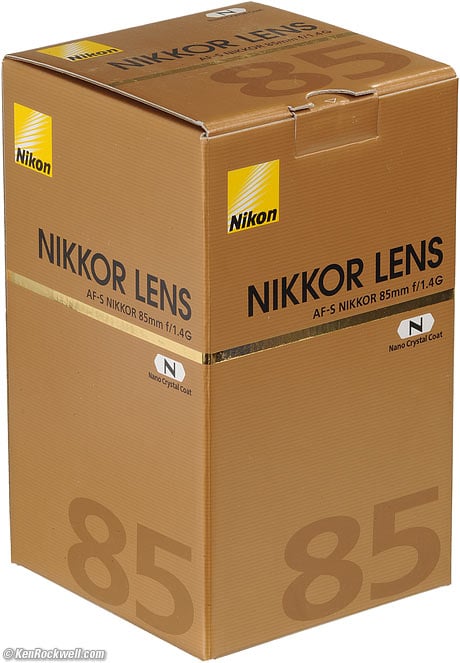
Box, Nikon 85mm f/1.4G.
Inside the box, the lens is cradled in a plastic orb thusly:
Central Orb, Nikon 85mm f/1.4G.
Price, USA top
$1,597, January 2017.
$1,599, December 2013.
$1,649, May 2013.
$1,699.95, September 2010 ~ April 2012.
$1,649.95 initial selling price, August 2010.
$1,699.95 catalog price, August 2010.
Performance top
Intro Specifications Performance Compared Recommendations
Overall Focus Bokeh Color Coma Distortion Ergonomics
Falloff Film, use on Filters Ghosts Hood Lateral Color Fringes
Mechanics Sharpness Spherochromatism Sunstars
Overall performance top
The Nikon 85mm f/1.4G AF-S is spectacular. The two previous 85/1.4s were also wonderful, and this new lens improves both ergonomically as well as optically.
Focus performance top
AF Accuracy on a D800
AF is almost always perfect, especially at f/1.4.
Beautiful!
AF Speed on a D3
AF speed is reasonable, but not instantaneous.
It does this to assure perfect focus at f/1.4, every time.
The 85/1.8D focuses more quickly.
AF Accuracy on a D3
AF accuracy is always dead-on at f/1.4.
Bravo! Very few lenses actually perform this well in the field.
Bokeh performance top
Bokeh, the character of out of focus backgrounds, not simply how far out of focus they are, is excellent! Hallelujah!
Too-hideous-to-publish sample image at f/1.4 (look at the bokeh, try to ignore the subject (you were warned), © 1.4 MB BASIC JPG shot in a dirty mirror)
This is expected, as soft backgrounds are the reason most people buy these.
Backgrounds just go away without distraction, yay!
Here are crops from the center of 100% FX 12MP (D3 or D700) images, focused on a reference phase lattice at 3 meters (10 feet) with synthetic reference vegetation at 15 meters (50 feet). Printed full-image at this size, these would be about 42 x 28" (105 x 70cm) prints, at least as seen on most 100 DPI computer monitors:
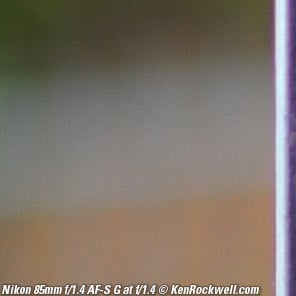 |
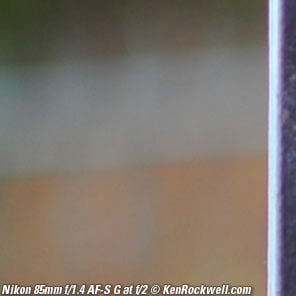 |
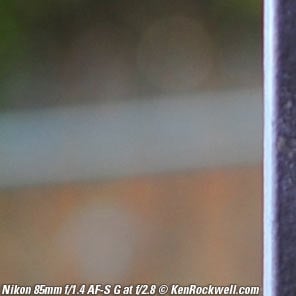 |
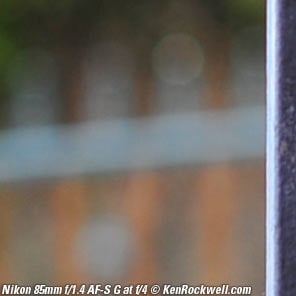 |
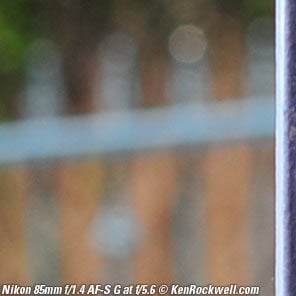 |
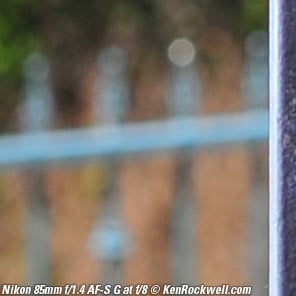 |
The fact that there is nothing but flatness in the f/1.4 and f/2 images is exactly what we want! It's not until f/2.8 where the blur circles even become circles at all, and even then, they are even, without emphasized edges.
This is extraordinary, and uses some clever spherochromatism to help out. Spherochromatism adds green fringes to background highlights, and since backgrounds are usually trees, makes them even softer. Brilliant!
Here's a complete image on full-frame at f/1.4:
Bokeh at f/1.4 on full-frame. full-resolution.
Color Rendition performance top
The color rendition looks the same as all my other modern NIKKORs.
Coma performance top
Coma (saggital coma flare) often causes weird smeared blobs to appear around bright points of light in the corners of fast or wide lenses at large apertures. In lenses that have it, coma goes away as stopped down.
Astoundingly, this 85/1.4G has no coma!
Nacht at f/1.4, 28 September 2010. Camera-orignainal © 1.5 MB BASIC JPG file.
Crop from bottom left corner of 12MP FX image at 100%. original file.
Compare this to the 85/1.4 AI-s at f/1.4:
85/1.4 AI-s at f/1.4, crop from bottom left corner of 12MP FX image at 100%.
Compare this to the exotic 58mm f/1.2 Noct-NIKKOR, stopped-down to f/1.4:
58/1.2 Noct at f/1.4, crop from bottom left corner of 12MP FX image at 100%.
This 85/1.4G is better than the 58 Noct at its own game, and people pay $3,000 for the Noct!
In case you're wondering just how far Nikon has brought optics with the introduction of this 85mm f/1.4, here's how well Nikon's current fastest in-production lens, the 50mm f/1.2 AI-s, looks stopped-down to f/1.4:
50/1.2 AI-s at f/1.4, crop from bottom left corner of 12MP FX image at 100%.
This 85mm f/1.4G AF-S is far superior to any of these other lenses for rendering point sources of light as point sources of light than even the exotic aspherical 58mm f/1.2 noct-NIKKOR, which was designed especially for this. This 85/1.4G also has much better bokeh than the Noct. Ha!
Distortion performance top
The Nikon 85mm f/1.4 G has an invisible bit of barrel distortion. I doubt anyone, including myself, will see it without access to a brick wall and a straight edge on playback.
For more critical use, it cleans up perfectly with these values in Photoshop's Lens Distortion filter.
FX and Film |
||
Infinity |
+1.0 |
+0.5 |
10' (3m) |
+1.0 |
+0.5 |
3' (1m) |
+0.4 |
© 2010 KenRockwell.com. All rights reserved.
Ergonomics (handling and ease-of-use) performance top
Nikon 85mm f/1.4 G. enlarge.
Ergonomics are perfect, a far cry better from the previous AF-D version which demanded the manual unlocking and moving of a hard AUTO-Manual focus mode ring.
The only control on this lens is the manual focus ring; just grab it at any time for instant manual-focus override.
The one M/A - M switch merely disables AF in the M mode. That's it.
Falloff (darkened corners) performance top
Falloff on FX isn't noticeable, at least on a D3 with Vignette Control turned ON.
It won't be an issue at all on DX (see crop factor).
I've exaggerated this by shooting a gray field and placing these on a gray background.
Once I did this, I'm surprised at how much there seems to be at f/1.4, since I never noticed it in real photos.
Nikon 85mm f/1.4 G AF-S falloff on FX and film at infinity, no correction.
© 2010 KenRockwell.com. All rights reserved.
|
35mm Film, use on performance top
The 85/1.4G works GREAT on 35mm film. It's super-sharp, even wide-open at f/1.4.
Film is a more forgiving medium than 12MP-and-up FX digital when it comes to lens performance, thus this stellar-on-digital lens looks incredible on film at any setting.
Filters, use with performance top
77mm is a generous filter size for this lens. There is no problem with vignetting, even with stacked thick filters.
The filter ring never moves or rotates.
Ghosts performance top
Even with the Nano-Crystal Coating hoo-hah, there are ghosts if you insist on pointing this big lens at the sun, and putting something dark in the foreground, you can get a ghost:
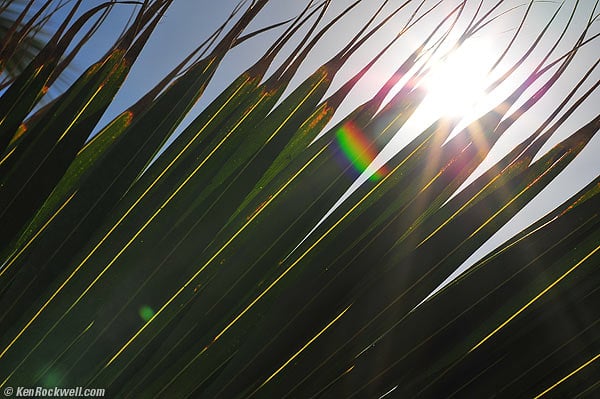
Nikon 85mm f/1.4 AFD G at f/16.
Hood performance top
The hood is a crappy bayonet plastic excrescence, not the real screw-in 77mm HN-31 hood of the 85/1.4 AF-D or the beautiful turned-aluminum 72mm HN-20 of the 85/1.4 AI-s.
I'll have to play; I'll bet you the screw-in HN-31 probably works great on this plasticy AFS lens.
Lateral Color Fringes performance top
There are no lateral color fringes on the 36 MP D800 or 12 MP D3, which would correct them if the lens had any.
I nearly fell over when I made a shot of my 30" Apple monitor and saw hellacious red/blue horizontal shifts. What happened is that the image was so ridiculously sharp that, for the first time ever, my D3's automatic correction algorithms saw the repeating RGB pixel lattice, and thought they were lateral color, so my D3 shifted the entire red and blue planes to make all my pixels look white, simultaneously putting hellacious shifts on everything else!
Weird, but this happened because the 85/1.4 is so good!
Mechanics and Construction performance top
Nikon 85mm f/1.4 G. enlarge.
The Nikon 85 1.4 G is a tough cookie. It has a plastic outside, like a motorcycle helmet, and feels like it will take a good beating. It's still not as tough as the 85/1.4 AF-D or 85/1.4 AI-s.
Hood
Plastic bayonet.
Hood Mount
Plastic.
Filter Threads
Plastic.
Ring between Filter Threads and Front Element
Metal.
Barrel Exterior
Plastic.
Focus Ring
Metal, rubber covered.
Depth-of-Field Scale
None; the two tits for f/16 don't count.
Internals
Metal.
Aperture Ring
None.
Mount
Dull-chromed brass.
Markings
Paint.
Identity Plate
Debossed metal.
Serial Number
Bottom, Nikon 85mm f/1.4. enlarge.
The serial number is an anodized aluminum sticker glued into an indentation in the bottom rear of barrel.
The USA version is signified by "US" prefix to serial number.
Dust seal at mount
Yes.
Noises when shaken
Mild thudding from the optics moving around.
Quality
Made in Japan.
Sharpness performance top
Warning 1: Image sharpness depends more on you than your lens.
Warning 2: Lens sharpness doesn't mean much to good photographers.
Sample image at f/1.4 (© 1.5MB BASIC JPG)
Nikon is getting too good. This 85/1.4 lens, used properly, is sharp at every aperture at every position in the field. If you need critical sharpness at the largest apertures, it's much better than earlier 85mm f/1.4 lenses.
This AFS G lens is sharp and contrasty right out to the edges at f/1.4, even on the Nikon D800 at 36 MP!
If looked at at 100% under ideal conditions at 36 MP, it's sharpest by f/4, but not much softer at all wide-open at f/1.4, which is much better than the earlier f/1.4 lenses.
There isn't anything else to say: it's sharp, sharp, sharp. There isn't anywhere that it's not sharp, but only if you have it in perfect focus.
Nikon's rated MTF curves:
Nikon's rated MTF.
Spherochromatism performance top
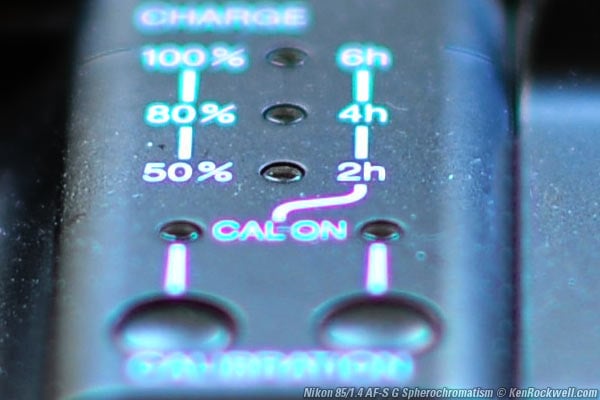
Spherochromatism (greatly enlarged).
There is potentially strong spherochromatism at large apertures, which is expected in long, fast lenses.
Spherochromatism, also referred to as "color bokeh" by laymen, causes background out-of-focus highlights take on green fringes, and foreground out-of-focus highlights take on magenta fringes.
This example is cropped from a 100% 12 MP FX D3 image. This exaggerates the actual effect, but there are always those who get concerned with this aberration.
Spherochromatism is completely unrelated to lateral color fringes (this is an axial color fringe), although laymen confuse these two very different kinds of aberrations.
This aberration is put to very intelligent use in this lens because it adds additional blur to green out-of-focus backgrounds, and especially blurs the edges of blur circles. This greatly improves green bokeh. Why would we want to improve green bokeh (blur green backgrounds better)? Because natural backgrounds are often masses of green trees, with spots of light shining through!
The brilliant design of the 85/1.4G capitalizes on this to make green backgrounds the smoothest, most velvety things I've ever seen.
Sunstars performance top
With its 9-bladed diaphragm becoming nonagonal at f/5.6 and smaller, it makes great 9- or 18-pointed sunstars on bright points of light as stopped down.
Compared performance top
Intro Specifications Performance Compared Recommendations
85mm f/1.4 AF-D (1995-2010), 85mm f/1.8 AF & D (1987-) and 85mm f/1.4 AF-S (2010-). enlarge.
85mm f/1.4 AI-s (1981-2006), 85mm f/1.4 AF-D (1995-2010) and 85mm f/1.4 AF-S (2010-). enlarge.
Nikon 85/1.8D, 85/1.8G, 85/1.4G and 85/1.4D. enlarge.
Ergonomics
The 85mm f/1.4 AF-D (1995-2010) is out, simply because of its clumsy auto-manual focus switch. Pros loved its optics, but good riddance to all the focus-mode fiddling.
The manual-focus 85mm f/1.4 AI-s is still excellent if you only focus manually. It's the only lens here with a useful focus and depth-of-field scale.
Optics
At large apertures, this new AF-S G version is clearly is better than the 85mm f/1.4 AF-D and the 85mm f/1.4 AI-s, by a large margin — if you're really picky.
Gone are the central chromatic aberration and spherical aberration issues of the earlier lenses.
At smaller apertures, these three 85/1.4 lenses are the same, except that the AF-D version never gets that sharp at the sides, while the AI-s and this AF-S lens certainly do.
For people on a size, weight or cash budget, the 85/1.8 AF-D is a far more practical lens. The 2/3 of a stop isn't particularly noticeable, the 85/1.8 often focuses faster, it has optics as good or better than the older lenses, but the f/1.8 85mm requires using the camera's AF mode switch to get between auto and manual focus. The 85/1.8 has been a winner ever since its introduction in 1987; don't pass it up.
Dry Specifications
Unlike other lenses, Nikon has kept the weights of their three 85/1.4s fairly similar across thirty years of innovation.
85/1.4 AF-S |
|||||
| Anni | 2010- |
1995-2010 |
1981-2005 |
1987- |
2009- |
| FIlter Ring | 77mm Plastic |
77mm Metal |
72mm Metal |
62mm Metal |
72mm Plastic |
| Optics | 10/9 |
9/8 |
7/5 |
6/6 |
7/9 |
| Center sharpness, wide open | Excellent |
Hazy |
Hazy |
Excellent |
|
| Center sharpness, f/2.8 | Excellent |
Excellent |
Excellent |
Excellent |
|
| Corner Sharpness, wide open | Excellent |
Hazy and softer |
Sharp but Hazy |
Very, very good |
|
| Corner Sharpness, f/5.6 | Excellent |
A little smeary |
Excellent |
Excellent |
|
| Distortion, 3m | +1.0 |
0 |
+0.4 |
0 |
+0.3 |
| Auto or Manual focus? | AF |
AF |
Manual |
AF |
Manual |
| Focus Technology | |||||
| Instant manual-focus override? | Yes |
no |
Yes |
no |
Yes |
| Depth-of-field scale | not really |
barely |
Yes |
barely |
no |
| Infra-red index | no |
Yes |
Yes |
Yes |
no |
| Close Focus | 0.85m |
0.85m |
0.85m |
0.85m |
1.0m |
| Maximum Repro Ratio | 1:8.3 |
1:8.8 |
1:7.9 |
1:9.2 |
|
| Diaphragm | 9 rounded |
9 rounded |
9 straight |
9 straight |
8 straight |
| Weight | 591g |
524g |
609g |
366g |
497g |
| Price, 8/2010 |
See also 85mm Lens Specifications Compared 23 June 2009
See also 85mm Lens Central Sharpness Comparison 23 June 2009
See also 85mm Lens Corner Sharpness Comparison 23 June 2009
Recommendations top
Intro Specifications Performance Compared Recommendations
If you're a pro, I'm sure you've already got yours.
The instant, full-time manual focus override is worth the price alone, even if it weren't for the incredible optics which give ultra-sharpness in-focus, and super-soft velvety backgrounds without even trying. This 85/1.4 does all this not just at f/1.4, but also at most apertures.
This 85mm f/1.4 G, along with Nikon's new 24mm f/1.4 G and 50mm f/1.4 AF-S, are pretty much the only three lenses you'd ever need for anything worth shooting, especially in low light. (Or replace the 24mm and 50mm with the 35mm f/1.4 G, or leave the 50 at home. You get the idea.)
We expect the 50mm f/1.2 AF-S G next to finish out the set of four fast pro lenses; the Chinese 50mm f/1.4 G is a consumer-grade lens. The 50/1.4 is superb optically, but probably not up to par mechanically for the long term.
If I haven't convinced you yet, go try one of these new 85s and look at the images. Look how your backgrounds just float away, while your subjects pop out as if they are three dimensional, at pretty much every aperture.
If you've found all the time and expense I've expended on researching and sharing all this information, this website's biggest source of support is when you use these links, especially this link directly to it at Adorama and at Amazon when you get anything, regardless of the country in which you live. Thank you! Ken.
Deployment top
I'd leave either a 77mm Nikon Clear (NC - UV) filter, or a 77mm Hoya Super HMC UV on the lens at all times. I would leave the hood at home.
If I was working in nasty, dirty areas, I'd forget the cap, and use an uncoated 77mm Tiffen UV filter instead. Uncoated filters are much easier to clean, but more prone to ghosting.
For color slides like Velvia 50, I use a 77mm Nikon A2 or 77mm Hoya HMC 81A outdoors.
For B&W film outdoors, I'd use a 77mm Nikon Y48 or O56 filter, or 77mm Hoya HMC K2 or 77mm Hoya HMC Orange.
More Information top
Nikon Australia's press release
© Ken Rockwell. All rights reserved. Tous droits réservés. Alle Rechte vorbehalten.
Help Me Help You
I support my growing family through this website, as crazy as it might seem.
The biggest help is when you use any of these links when you get anything. It costs you nothing, and is this site's, and thus my family's, biggest source of support. These places always have the best prices and service, which is why I've used them since before this website existed. I recommend them all personally.
If you find this page as helpful as a book you might have had to buy or a workshop you may have had to take, feel free to help me continue helping everyone.
If you've gotten your gear through one of my links or helped otherwise, you're family. It's great people like you who allow me to keep adding to this site full-time. Thanks!
If you haven't helped yet, please do, and consider helping me with a gift of $5.00.
As this page is copyrighted and formally registered, it is unlawful to make copies, especially in the form of printouts for personal use. If you wish to make a printout for personal use, you are granted one-time permission only if you PayPal me $5.00 per printout or part thereof. Thank you!
Thanks for reading!
Mr. & Mrs. Ken Rockwell, Ryan and Katie.

